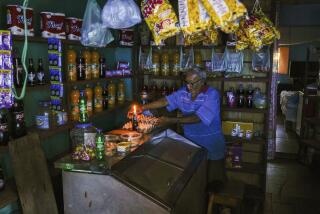Oil Strike Has Taken Its Toll, Venezuelan Says
- Share via
CARACAS, Venezuela A — CARACAS, Venezuela -- In his first extensive remarks to U.S. reporters since a nationwide strike crippled oil production, the president of Venezuela’s state petroleum company acknowledged Tuesday that the work stoppage had racked the nation’s economy.
But Ali Rodriguez, president of Petroleos de Venezuela, or PDVSA, said in an interview that the government had managed to restart production, and he predicted that oil shipments from the country, which supplies 15% of U.S. imports, would return to normal by next month.
Rodriguez’s comments, combined with recent oil tanker departures and gasoline deliveries, were the first concrete signs that President Hugo Chavez’s government has succeeded in beating back the immediate threat of economic or political collapse.
“The strike is being defeated,” Rodriguez said. He estimated that the 23-day-old strike had resulted in a loss of $1.3 billion to the oil industry, which accounts for half the government’s budget and a third of its $124-billion gross domestic product.
Rodriguez said Venezuela would ship less than 2 million barrels of oil for December as a result of the strike, which shut down wells, refineries and transport. Normally, it exports about 2.7 million barrels a day.
“It’s a damage of great proportions,” Rodriguez said. “There’s been damage done to the nation.”
Nonetheless, the former president of the Organization of the Petroleum Exporting Countries said striking oil workers -- some of whom he said would be arrested for their participation in the walkout -- had failed to destabilize the government.
Striking oil workers said Tuesday that Rodriguez had fired 90 managers. He acknowledged that some people had been fired, but he declined to provide details.
“They have created difficulties, but we have been overcoming them. We have had problems with distribution, but at the end of this week, the country will be totally supplied with gasoline,” Rodriguez said. Gas lines continued to snake for miles Tuesday, with many motorists spending the night in their cars.
“In the month of January, we will have completely normalized the flow. I’m talking about the exports of crude,” he added.
Political opponents and oil analysts were skeptical of Rodriguez’s remarks. They said that even if all oil workers returned to their jobs, it would take at least a month to get the paralyzed production chain operating again at full speed. However, they acknowledged that the government had turned a corner, at least for the time being.
“The worst is over” for the government, said Ramon Espinasa, a consultant for the Inter-American Development Bank and former chief economist for PDVSA, who opposes Chavez. “However, the government will face long-term problems down the road.”
Chavez, a fiery leftist, has launched an ill-defined “revolution” to rescue the country’s poor. The scattered opposition, which enjoys broad support among the labor and business sectors and rival politicians, seeks to oust him. Chavez was briefly felled in a coup in April, but he returned to power two days later, aided by loyal military units.
The opposition now is demanding that Chavez resign and hold new elections by early next year. Chavez has said a referendum on his rule is not allowed by the constitution until August.
Negotiations between the two sides have been going on since November. But with Chavez still in control of the military and able to maintain at least minimum operating levels in the oil industry, there are worries that the protest could drag on for weeks, if not months.
That, in turn, could complicate a possible U.S. invasion of Iraq. The strike in Venezuela has already sent oil prices to more than $30 a barrel, and a war in the Middle East would push prices even higher.
“One side thinks the strike is using up the last drops of oil. The other side thinks it’s reactivating the industry. I don’t know how long the stalemate can go on,” said a source close to the talks, which will be resumed Thursday after a two-day suspension.
A former communist guerrilla, Rodriguez appeared remarkably at ease for a man who has spent the last month performing CPR on the heart of the nation’s economy.
He talked at length about the measures PDVSA had taken to beat back the strike, which opposition members say is being heeded by as many as 35,000 of the 60,000 PDVSA workers, the majority in administrative and executive positions.
Even as Rodriguez spoke in a wood-paneled penthouse suite filled with sculptures and oil paintings, a hard-core band of Chavez supporters on the street below continued to ring the headquarters building to protect it from opposition marchers.
Rodriguez said PDVSA has supplied information to the attorney general’s office to help it carry out both civil and criminal trials against oil executives, who he said had engaged in a deliberate plot to cripple the industry.
He also said PDVSA was preparing to purchase gasoline from abroad and import foreign workers, including experts from Europe and the U.S., to provide advice about a restructuring that would mean fewer workers and affiliated companies.
He acknowledged that production was still frozen at the largest refinery in the Western Hemisphere, the Paraguana Refinery Center, which normally produces nearly a million barrels a day. But two smaller refineries, most of whose production is dedicated to fulfilling Venezuela’s internal needs, were operating at partial capacity with the help of nonstriking workers and the rehiring of workers who had retired or had been fired from their jobs.
Chavez’s success was visible Monday on Lake Maracaibo, the historical heart of the country’s oil industry. There, sitting in the shallow waters just offshore from a refinery, the oil tanker Pilin Leon was unloading gasoline.
The Pilin Leon had become a symbol for the opposition after the ship’s crew joined the strike. It sat on the lake for 19 days until the government arrested the captain and installed a replacement crew Saturday.
By Monday, PDVSA workers and gas truck drivers had managed to unload nearly all of the tanker’s 11 million gallons of gasoline, enough to supply Maracaibo, Venezuela’s second-largest city, for up to 10 days.
As the day progressed, drivers could be seen around the city, tailing bright-orange delivery trucks as they pulled up to service stations to refill underground tanks.
Danilo Garcia, western director for the Ministry of Mines and Energy, said a work force reduced by 50% because of the strike had managed the feat by working around the clock.
“It’s a titanic job. But we’ve done it,” Garcia said.
More to Read
Sign up for Essential California
The most important California stories and recommendations in your inbox every morning.
You may occasionally receive promotional content from the Los Angeles Times.













